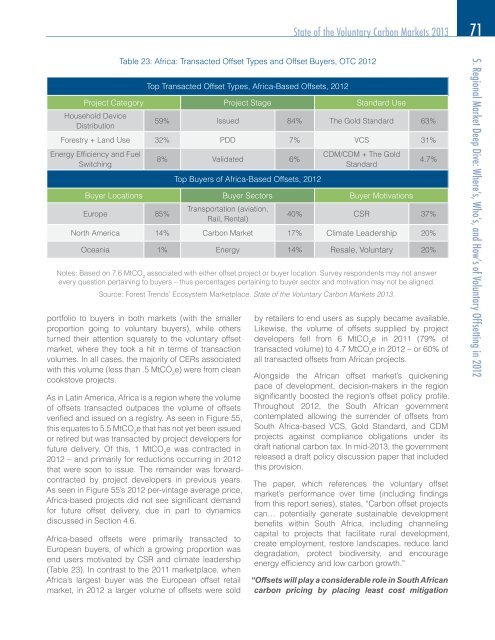Maneuvering the Mosaic: Full Report - Forest Trends
Maneuvering the Mosaic: Full Report - Forest Trends
Maneuvering the Mosaic: Full Report - Forest Trends
Create successful ePaper yourself
Turn your PDF publications into a flip-book with our unique Google optimized e-Paper software.
portfolio to buyers in both markets (with <strong>the</strong> smaller<br />
proportion going to voluntary buyers), while o<strong>the</strong>rs<br />
turned <strong>the</strong>ir attention squarely to <strong>the</strong> voluntary offset<br />
market, where <strong>the</strong>y took a hit in terms of transaction<br />
volumes. In all cases, <strong>the</strong> majority of CERs associated<br />
with this volume (less than .5 MtCO 2 e) were from clean<br />
cookstove projects.<br />
As in Latin America, Africa is a region where <strong>the</strong> volume<br />
of offsets transacted outpaces <strong>the</strong> volume of offsets<br />
verifi ed and issued on a registry. As seen in Figure 55,<br />
this equates to 5.5 MtCO 2 e that has not yet been issued<br />
or retired but was transacted by project developers for<br />
future delivery. Of this, 1 MtCO 2 e was contracted in<br />
2012 – and primarily for reductions occurring in 2012<br />
that were soon to issue. The remainder was forwardcontracted<br />
by project developers in previous years.<br />
As seen in Figure 55’s 2012 per-vintage average price,<br />
Africa-based projects did not see signifi cant demand<br />
for future offset delivery, due in part to dynamics<br />
discussed in Section 4.6.<br />
Africa-based offsets were primarily transacted to<br />
European buyers, of which a growing proportion was<br />
end users motivated by CSR and climate leadership<br />
(Table 23). In contrast to <strong>the</strong> 2011 marketplace, when<br />
Africa’s largest buyer was <strong>the</strong> European offset retail<br />
market, in 2012 a larger volume of offsets were sold<br />
Top Transacted Offset Types, Africa-Based Offsets, 2012<br />
State of <strong>the</strong> Voluntary Carbon Markets 2013 71<br />
Project Category Project Stage Standard Use<br />
Household Device<br />
Distribution<br />
59% Issued 84% The Gold Standard 63%<br />
<strong>Forest</strong>ry + Land Use 32% PDD 7% VCS 31%<br />
Energy Effi ciency and Fuel<br />
Switching<br />
Table 23: Africa: Transacted Offset Types and Offset Buyers, OTC 2012<br />
8% Validated 6%<br />
Top Buyers of Africa-Based Offsets, 2012<br />
CDM/CDM + The Gold<br />
Standard<br />
Buyer Locations Buyer Sectors Buyer Motivations<br />
Europe 85%<br />
Transportation (aviation,<br />
Rail, Rental)<br />
4.7%<br />
40% CSR 37%<br />
North America 14% Carbon Market 17% Climate Leadership 20%<br />
Oceania 1% Energy 14% Resale, Voluntary 20%<br />
Notes: Based on 7.6 MtCO associated with ei<strong>the</strong>r offset project or buyer location. Survey respondents may not answer<br />
2<br />
every question pertaining to buyers – thus percentages pertaining to buyer sector and motivation may not be aligned.<br />
Source: <strong>Forest</strong> <strong>Trends</strong>’ Ecosystem Marketplace. State of <strong>the</strong> Voluntary Carbon Markets 2013.<br />
by retailers to end users as supply became available.<br />
Likewise, <strong>the</strong> volume of offsets supplied by project<br />
developers fell from 6 MtCO 2 e in 2011 (79% of<br />
transacted volume) to 4.7 MtCO 2 e in 2012 – or 60% of<br />
all transacted offsets from African projects.<br />
Alongside <strong>the</strong> African offset market’s quickening<br />
pace of development, decision-makers in <strong>the</strong> region<br />
signifi cantly boosted <strong>the</strong> region’s offset policy profi le.<br />
Throughout 2012, <strong>the</strong> South African government<br />
contemplated allowing <strong>the</strong> surrender of offsets from<br />
South Africa-based VCS, Gold Standard, and CDM<br />
projects against compliance obligations under its<br />
draft national carbon tax. In mid-2013, <strong>the</strong> government<br />
released a draft policy discussion paper that included<br />
this provision.<br />
The paper, which references <strong>the</strong> voluntary offset<br />
market’s performance over time (including fi ndings<br />
from this report series), states, “Carbon offset projects<br />
can… potentially generate sustainable development<br />
benefi ts within South Africa, including channeling<br />
capital to projects that facilitate rural development,<br />
create employment, restore landscapes, reduce land<br />
degradation, protect biodiversity, and encourage<br />
energy effi ciency and low carbon growth.”<br />
“Offsets will play a considerable role in South African<br />
carbon pricing by placing least cost mitigation<br />
5. Regional Market Deep Dive: Where’s, Who’s, and How’s of Voluntary Offsetting in 2012
















